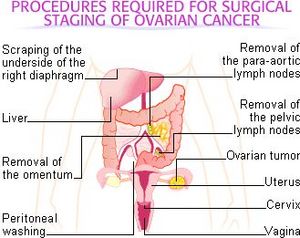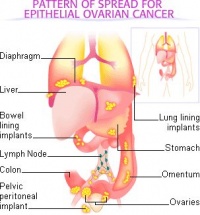Ovarian Cancer
Ovarian cancer describes tumors of the ovary, fallopian tube, and neighboring intestinal wall lining (peritoneum). It is further categorized into different types based upon the tissue where the cancer initially developed. Most, but not all, of ovarian cancers are carcinomas of epithelial origin.[1] Incidence of ovarian cancer is relatively rare and often difficult to diagnose due to the nonspecific nature of the symptoms. Although ovarian cancer is rare it is considered one of the most lethal of gynecological cancers.[2]
| Causes | Dietary imbalances, Environmental Toxins, Prescription medications. |
|---|---|
| See Also | Women's Health, Oncology |
| Books | Books on Women's Health, Books on Oncology |
| Articles | Articles on Women's Health, Articles on Oncology (Cancer) |
| Article | Ovarian cancer: A naturopathic perspective, IHP, Nov/Dec 2009 |
|---|
| Article | Chronic Stress and Ovarian Cancer Progression , April 2013 Natural Medicine [1] |
|---|
Naturopathic Assessment
Causal Factors
In order to stimulate the innate ability of the body to heal the causes of disease must be identified and addressed. A detailed assessment is required to determine which factors are contributory.
Lifestyle
Environmental
- Living in a sunny climate decreases the risk of ovarian cancer, presumably due to increased exposure to vitamin D. [4]
- Most of the data on environmental exposures and ovarian cancer risk comes from the association of certain occupations with ovarian cancer.
- Heavy exposure to solvents, dyes, and electromagnetic fields appears to increase the risk of ovarian cancer. Several of these dyes are known carcinogens. [5] Notably, several chemotherapies were developed from carcinogenic dyes, as substances known to cause cancer were repurposed to treat cancer. [6]
External
- Increased risk of ovarian cancer with use of talcum powder products on the vulva. [7]
Medical Interventions
- Prescription Medications
- Decreased risk of ovarian cancer in patients who use oral contraceptive pills or have had any of the following procedures: surgical removal of the uterus (hysterectomy), surgical obstruction of the fallopian tubes (tubal ligation), or surgical removal of the ovaries (oophorectomy).[8]
- Increased risk of ovarian cancer in postmenopausal women who take hormone replacement therapy with either estrogen or progestins. [9]
- The chemotherapy drug Doxorubicin stimulates the growth of ovarian cancer stem cells. [10]
- Medical Treatments
- Mixed data regarding the impact of in vitro fertilization and fertility enhancing drugs on ovarian cancer risk.[11]
- In those women with Lynch Syndrome, BRCA mutation, or those at high risk for ovarian cancer, preventive removal of the ovaries and fallopian tubes decreases the risk of developing ovarian cancer.[12]
Genetics
- Although there tends to be a familial link to ovarian cancer risk, genetics and family history are estimated to account for only 4 to 5 percent of ovarian cancer cases.[13]
- Genetic syndromes associated with familial ovarian cancer include BRCA mutation, Lynch syndrome, and hereditary breast and ovarian cancer syndrome. Patients may consider consulting a genetic counselor if there are multiple cases of breast, ovarian, and/or colon cancer in an immediate genetic family. Genetic counseling is particularly advisable if several of these cases develop in people under age 40.[14]
- Some ovarian cancers have the Her-2 Neu receptor and gene activated. Her-2 Neu drives tumor growth and is a potential target for therapy. [15]
- Genetics can impact the processing of internal and environmental carcinogens. A genetic variation (polymorphism) of CYP1A1 is associated with increased risk of ovarian cancer. CYP1A1 detoxifies carcinogens from estrogen and from pollutants made by burning things. Burning things produces polycyclic aromatic hydrocarbons, a known carcinogen present in soot, smoke, exhaust fumes, and barbequed meat.[16]
- Cultural
- Ethnicity affects ovarian cancer risk. The cause of this trend is not fully understood. Caucasian women have a 50% higher risk of ovarian cancer compared to African American women. Some of this trend may be due the increased prevalence of the BRCA mutation among white women of Eastern European (Ashkenazi) origin.[17]
Physiology
- Pregnancy and breastfeeding decrease the risk of ovarian cancer, presumably by decreasing the lifetime number of ovulations.
- Sources of female hormones include physiologic estrogen dominance, environmental xenoestrogens, and hormone replacement therapy.
Diagnostic Tests
- Blood tests that are often requested included tumor markers such as CEA and CA 125, Liver function tests, and CBC. A specialty blood test can assess genetic variations in detoxification pathways that can contribute to the development of ovarian cancer; the test results can guide a personalized detoxification and toxin avoidance program.
- In addition to a comprehensive physical exam, a pelvic ultrasound and/or contrast pelvic CT or MRI imaging may be used.
- Detection of ovarian cancer is usually confirmed histologically by biopsy after a physical exam, pelvic transvaginal ultrasound, and/or pelvic MRI reveals a pelvic mass.
- Following biopsy, a surgeon may recommend complete surgical staging to assess the extent of disease. Complete surgical staging of early stage disease should include sampling tissue from the multiple sites shown above. Correct staging is very important for predicting outcomes (prognosis) and understanding which treatments will be best. Up to 30% of women who were thought to have ovary-only disease will be found to have more extensive disease upon complete surgical staging.[21]
Related Symptoms and Conditions
- Women who have had more ovulations are at higher risk for developing ovarian cancer. This includes women who have never had children, and women who started menstruating young (early menarche) or stopped menstruating later (late menopause).[22]
- Among women with ovarian cancer, those with diabetes have poorer survival.[23]
- Complications of advanced ovarian cancer include ascites, bowel obstruction, and cachexia. Proper supportive care for and prevention of these conditions can significantly improve quality of life and survival.
Characteristics
Ovarian cancers are characterized by their stage, tissue subtype, and molecular markers. Ovarian cancers are typically diagnosed at a late stage, with approximately 80% of patients diagnosed at stage III or IV.[24]
- New evidence indicates that there may be two main subtypes of ovarian cancer, type I and type II, and that subtype may be a better predictor of outcomes than stage. Type I is slow growing whereas type II is rapidly growing.[25]
- Ovarian cancer can spread to many places throughout the abdomen and pelvis, yielding diffuse and nonspecific symptoms.
The symptoms indicating ovarian cancer are often nonspecific. These symptoms are more suspicious if they have developed over the past year, if they are not responsive to other treatments, and if they are getting steadily worse.
- The nonspecific symptoms include fatigue, bloating, abdominal distention, indigestion, constipation and feeling full after eating a little food (early satiety).
- Other symptoms that are more indicative of pelvic disease and that often indicate further investigation include pressure or discomfort on the bladder and rectum, vaginal bleeding, or weight loss.
- If an abdominal or ovarian mass is detected it is advisable to investigate further.
- Some studies have found that symptoms more strongly associated with ovarian cancer are a combination of bloating, increased size of the abdomen, and urinary symptoms. [26]
Naturopathic Treatment
The goal of naturopathic treatment is to support and work in tandem with the healing power of the body. A treatment strategy is the most effective when it addresses the underlying causal factors. The treatment for ovarian cancer depends on the staging (progression) of the cancer, an individual's symptoms, vitality and other conditions. The treatment strategies include: Prevention, Cancer Specific Treatments, Supportive Care and Prevent Recurrence.
It is always advisable to work with a naturopathic doctor before engaging in any treatment plan.
Cancer Specific Treatments
Follow the general guidelines for cancer specific treatments. Additional treatments that are specific to ovarian cancer include:
- Dietary recommendations include increasing the intake of whole foods, and plant-based protein while decreasing the consumption of dairy products.
- Supplementation such as Vitamin D, Vitamin C, Melatonin, essential fatty acids, Indole-3-Carbinol, Di-Indolyl Methane, Resveratrol, Sulforaphane, Modified Citrus Pectin
- Herbs such as Turmeric (Curcuma longa), Green Tea Extract, Morning glory (Convolvulus),
- Acupuncture focusing on decreasing dampness in the middle jiao and lower jiao while tonifying qi.
- Intravenous Vitamin C therapy has been beneficial in case reports and is being studied in a clinical trial. [27] [28]
Supportive Care
Follow the general guidelines for supportive care especially when conventional treatments such as surgery or radiation therapy are chosen. Specific considerations for ovarian cancer include:
| Article | Metformin Improves Ovarian Cancer Survival, NMJ, [2], 2012 August |
|---|
- Ovarian cancer tends to respond to chemotherapy and then recur. [29] Natural therapies to increase chemotherapy sensitivity and to target the tumor are particularly indicated.
- If surgical debulking of the tumor is indicated, your naturopathic doctor can also help you to prepare for and recover from surgery. This can include supporting wound healing, reducing development of post surgical adhesions, supporting pain control, and removing supplements, foods, or medications that can interfere with anesthesia or blood clotting. For women with newly diagnosed ovarian cancer, the most important factor for prognosis is the extent of surgical debulking, with a optimal margin of < 1 centimeter. [30] Surgery done by a gynecologic oncologist is associated with better outcomes than surgery performed by a general surgeon.[31]
Prevent Recurrence
- Prevention of recurrence involves addressing the relevant causal factors and using appropriate cancer specific treatments.
- Due to the biology of ovarian cancer, epithelial ovarian tumors tend to respond to chemotherapy and then recur. [32] Recurrent tumors can respond again to conventional treatment, but they progressively develop treatment resistance. [33] For these reasons, an ongoing prevention of recurrence strategy is very important for women with ovarian cancer.
References
- ↑ http://www.ncbi.nlm.nih.gov/pubmed/18395030
- ↑ Jemal A, Murrary T, Ward E eta al. Cancer Statistics 2005 CA Cancer J Clinic. 2005;55:10-30.
- ↑ http://www.ajcn.org/content/80/5/1353.full
- ↑ http://www.ncbi.nlm.nih.gov/pubmed/7721513
- ↑ http://www.ajcn.org/content/80/5/1353.full
- ↑ "The Emperor of All Maladies: A Biography of Cancer" by Siddhartha Mukherjee
- ↑ http://emedicine.medscape.com/article/255771-overview#aw2aab6b2b3aa
- ↑ http://www.ncbi.nlm.nih.gov/pubmed/18294997
- ↑ http://jama.ama-assn.org/content/302/3/298.full
- ↑ K. Meirelles et al. Human ovarian cancer stem/progenitor cells are stimulated by doxorubicin but inhibited by Mullerian inhibiting substance. Proceedings of the National Academy of Sciences. Published online the week of January 23, 2012.
- ↑ http://www.ncbi.nlm.nih.gov/pubmed/15705362
- ↑ http://www.ncbi.nlm.nih.gov/pubmed/16835424
- ↑ http://www.healthandenvironment.org/ovarian_cancer
- ↑ “The Biology of Cancer” from: Clinical Oncology : A Multi- Disciplinary Approach, 8th edition by Rubin (ed.)
- ↑ “The Biology of Cancer” from: Clinical Oncology : A Multi- Disciplinary Approach, 8th edition by Rubin (ed.)
- ↑ http://www.healthandenvironment.org/ovarian_cancer
- ↑ http://www.healthandenvironment.org/ovarian_cancer
- ↑ http://jama.ama-assn.org/content/302/3/298.full
- ↑ http://www.ncbi.nlm.nih.gov/pubmed/18294997
- ↑ http://www.ncbi.nlm.nih.gov/pubmed/18395030
- ↑ http://www.ncbi.nlm.nih.gov/pubmed/19332244
- ↑ http://www.ncbi.nlm.nih.gov/pubmed/18061864
- ↑ http://www.ncbi.nlm.nih.gov/pubmed/21236474
- ↑ http://www.ncbi.nlm.nih.gov/pubmed/18395030
- ↑ http://www.ncbi.nlm.nih.gov/pubmed/19332244
- ↑ http://www.ncbi.nlm.nih.gov/pubmed/15187051
- ↑ http://www.ncbi.nlm.nih.gov/pubmed/12672707
- ↑ http://www.ncbi.nlm.nih.gov/pubmed/12648599
- ↑ http://www.ncbi.nlm.nih.gov/pubmed/19332244
- ↑ http://www.ncbi.nlm.nih.gov/pubmed/18395030
- ↑ http://www.ncbi.nlm.nih.gov/pubmed/19332244
- ↑ http://jnci.oxfordjournals.org/content/101/18/1234.full.pdf
- ↑ http://www.thelancet.com/journals/lanonc/article/PIIS1470-2045(11)70123-1/abstract

